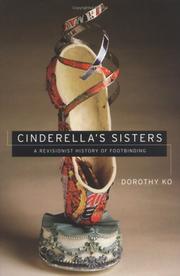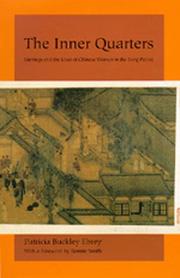| Listing 1 - 4 of 4 |
Sort by
|
Book
ISBN: 0295744421 9780295744421 9780295744414 9780295744407 0295744405 0295744413 Year: 2018 Publisher: Seattle, Washington : University of Washington Press,
Abstract | Keywords | Export | Availability | Bookmark
 Loading...
Loading...Choose an application
- Reference Manager
- EndNote
- RefWorks (Direct export to RefWorks)
Previous studies of the practice of footbinding in imperial China have theorized that it expressed ethnic identity or that it served an economic function. By analyzing the popularity of footbinding in different places and times, Footbinding as Fashion investigates the claim that early Qing (1644–1911) attempts by Manchu rulers to ban footbinding made it a symbol of anti-Manchu sentiment and Han identity and led to the spread of the practice throughout all levels of society. Detailed case studies of Taiwan, Hebei, and Liaoning provinces exploit rich bodies of previously neglected ethnographic reports, economic surveys, and rare censuses of footbinding to challenge the significance of sedentary female labor and ethnic rivalries as factors leading to the hegemony of the footbinding fashion. The study concludes that, independently of identity politics and economic factors, variations in local status hierarchies and elite culture coupled with status competition and fear of ridicule for not binding girls’ feet best explain how a culturally arbitrary fashion such as footbinding could attain hegemonic status.
Footbinding --- Women --- Binding of feet --- Foot --- Foot-binding --- Deformities, Artificial --- History. --- Employment --- Social conditions. --- Artificial deformities --- Binding --- Abnormalities --- S11/0710 --- S11/0742 --- History --- Social conditions --- China: Social sciences--Women and gender: general and before 1949 --- China: Social sciences--Footbinding
Book
ISBN: 9780804799553 9781503601079 1503601072 0804799555 Year: 2017 Publisher: Stanford, California
Abstract | Keywords | Export | Availability | Bookmark
 Loading...
Loading...Choose an application
- Reference Manager
- EndNote
- RefWorks (Direct export to RefWorks)
Footbinding was common in China until the early twentieth century, when most Chinese were family farmers. Why did these families bind young girls' feet? And why did footbinding stop? In this groundbreaking work, Laurel Bossen and Hill Gates upend the popular view of footbinding as a status, or even sexual, symbol by showing that it was an undeniably effective way to get even very young girls to sit still and work with their hands. Interviews with 1,800 elderly women, many with bound feet, reveal the reality of girls' hand labor across the North China Plain, Northwest China, and Southwest China. As binding reshaped their feet, mothers disciplined girls to spin, weave, and do other handwork because many village families depended on selling such goods. When factories eliminated the economic value of handwork, footbinding died out. As the last generation of footbound women passes away, Bound Feet, Young Hands presents a data-driven examination of the social and economic aspects of this misunderstood custom.
Footbinding --- Rural girls --- Rural women --- Handicraft industries --- S11/0480 --- S11/0710 --- S11/0742 --- Women --- Country girls --- Girls --- Rural children --- Binding of feet --- Foot --- Foot-binding --- Deformities, Artificial --- Economic aspects --- Employment --- Social life and customs. --- China: Social sciences--Rural life, rural studies: general and before 1949 --- China: Social sciences--Women: general and before 1949 --- China: Social sciences--Footbinding --- Artificial deformities --- Binding --- Abnormalities --- China --- Rural conditions. --- Social life and customs

ISBN: 0520218841 9780520218840 9786612360435 0520941403 9780520941403 9780520253902 0520253906 1282360434 Year: 2005 Publisher: Berkeley University of California Press
Abstract | Keywords | Export | Availability | Bookmark
 Loading...
Loading...Choose an application
- Reference Manager
- EndNote
- RefWorks (Direct export to RefWorks)
The history of footbinding is full of contradictions and unexpected turns. The practice originated in the dance culture of China's medieval court and spread to gentry families, brothels, maid's quarters, and peasant households. Conventional views of footbinding as patriarchal oppression often neglect its complex history and the incentives of the women involved. This revisionist history, elegantly written and meticulously researched, presents a fascinating new picture of the practice from its beginnings in the tenth century to its demise in the twentieth century. Neither condemning nor defending foot-binding, Dorothy Ko debunks many myths and misconceptions about its origins, development, and eventual end, exploring in the process the entanglements of male power and female desires during the practice's thousand-year history. Cinderella's Sisters argues that rather than stemming from sexual perversion, men's desire for bound feet was connected to larger concerns such as cultural nostalgia, regional rivalries, and claims of male privilege. Nor were women hapless victims, the author contends. Ko describes how women-those who could afford it-bound their own and their daughters' feet to signal their high status and self-respect. Femininity, like the binding of feet, was associated with bodily labor and domestic work, and properly bound feet and beautifully made shoes both required exquisite skills and technical knowledge passed from generation to generation. Throughout her narrative, Ko deftly wields methods of social history, literary criticism, material culture studies, and the history of the body and fashion to illustrate how a practice that began as embodied lyricism-as a way to live as the poets imagined-ended up being an exercise in excess and folly.
S11/0710 --- S11/0742 --- China: Social sciences--Women: general and before 1949 --- China: Social sciences--Footbinding --- Footbinding --- Bandage des pieds --- History --- Pathology --- Sociology of the family. Sociology of sexuality --- Human physiology --- China --- Binding of feet --- Foot --- Foot-binding --- Deformities, Artificial --- Artificial deformities --- Binding --- Abnormalities --- Social aspects. --- Feet --- Paw --- Paws --- Leg --- age of disavowal. --- beauty. --- china. --- chinese culture. --- chinese history. --- cultural nostalgia. --- dance culture. --- embodied lyricism. --- fangzu. --- fashion and clothing. --- female body. --- female desire. --- femininity. --- footbinding. --- gender expectations. --- gender performance. --- gender studies. --- high status. --- historical. --- history. --- imaginary geography. --- male desire. --- male power. --- male privilege. --- material culture studies. --- medieval court. --- men and women. --- patriarchal oppression. --- political. --- regional rivalry. --- self respect. --- social history. --- tianzu. --- Mutilations --- Images of women --- Female body --- Book

ISBN: 0520913485 0585104344 9780520913486 9780585104348 9780520081567 9780520081581 0520081560 0520081587 Year: 1993 Publisher: Berkeley, CA : University of California Press,
Abstract | Keywords | Export | Availability | Bookmark
 Loading...
Loading...Choose an application
- Reference Manager
- EndNote
- RefWorks (Direct export to RefWorks)
The Sung Dynasty (960-1279) was a paradoxical era for Chinese women. This was a time when footbinding spread, and Confucian scholars began to insist that it was better for a widow to starve than to remarry. Yet there were also improvements in women's status in marriage and property rights. In this thoroughly original work, one of the most respected scholars of premodern China brings to life what it was like to be a woman in Sung times, from having a marriage arranged, serving parents-in-law, rearing children, and coping with concubines, to deciding what to do if widowed. Focusing on marriage, Patricia Buckley Ebrey views family life from the perspective of women. She argues that the ideas, attitudes, and practices that constituted marriage shaped women's lives, providing the context in which they could interpret the opportunities open to them, negotiate their relationships with others, and accommodate or resist those around them. Ebrey questions whether women's situations actually deteriorated in the Sung, linking their experiences to widespread social, political, economic, and cultural changes of this period. She draws from advice books, biographies, government documents, and medical treatises to show that although the family continued to be patrilineal and patriarchal, women found ways to exert their power and authority. No other book explores the history of women in pre-twentieth-century China with such energy and depth.
Marriage --- Women --- Sociology & Social History --- Social Sciences --- Family & Marriage --- History. --- Social conditions. --- History --- Social conditions --- China --- History of Asia --- anno 900-999 --- anno 1000-1099 --- anno 1100-1199 --- anno 1200-1299 --- 20th century. --- academic. --- advice. --- arranged marriage. --- biography. --- chinese dynasty. --- chinese women. --- concubines. --- culture. --- dynastic. --- economics. --- feminism. --- feminist. --- footbinding. --- gender studies. --- government. --- marriage. --- medical. --- patriarchal. --- patriarchy. --- politics. --- premodern china. --- property rights. --- raising children. --- relationships. --- scholarly. --- sung dynasty. --- true story. --- widow. --- women in china. --- womens issues. --- womens rights. --- womens studies. --- world history.
| Listing 1 - 4 of 4 |
Sort by
|

 Search
Search Feedback
Feedback About UniCat
About UniCat  Help
Help News
News